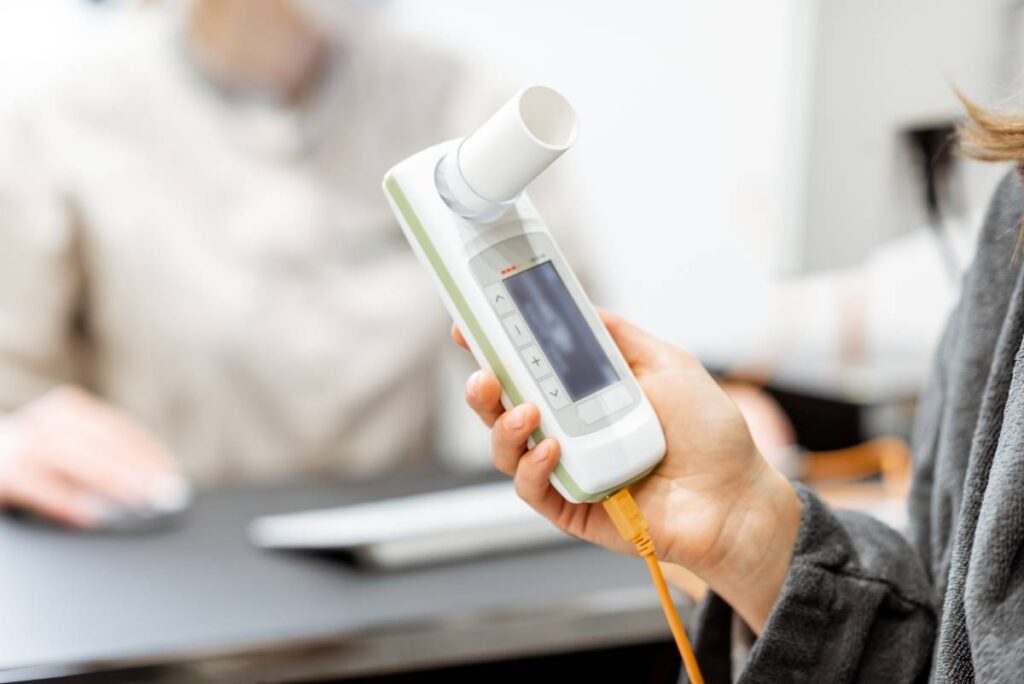Two weeks ago, the FDA granted emergency use authorization (EUA) for the InspectIR COVID-19 Breathalyzer, the first breath test for SARS-CoV-2 infection that has received such status in the US. The EUA is for the “near patient/point-of-care” setting, meaning settings in which the patient specimen is both collected and analyzed, as compared to PCR tests that often must be sent to a laboratory. In addition, the test must be performed by a trained operator, as compared to at-home test kits. The major advantage provided by the Covid breathalyzer is its ability to provide results in under 3 minutes – rapid antigen tests typically take 15-30 minutes – potentially paving the way for high flow testing scenarios [1][2].
Breath analysis is an active area of research in the field of medical technology, due to the relative convenience and comfort of measuring substances in the breath as opposed to nose/mouth swabs or blood tests. The most prominent use of this technology is the alcohol breathalyzer commonly used by law enforcement. Researchers are also pursuing breath analysis for detecting cancer, inflammatory bowel disease, and other diseases, including several respiratory ones. Disruption to physiological processes due to disease may have measurable effects on the presence and levels of volatile organic compounds in our bodies, which can cross from our blood into our breath via the surface of our lungs; capturing those changes is the goal of the various breathalyzer tests in development, [2-4].
The InspectIR COVID-19 Breathalyzer relies on gas chromatography-mass spectrometry, a technique that combines data from gas chromatography, which separates compounds based on certain properties (e.g., molecular size or charge), and mass spectrometry, which measures the mass-to-charge ratio of fragments of the compound. Together, this allows for more precise identification of compounds [1]. In particular, the device measures the levels of five aldehydes and ketones that are associated with Covid [2][3].
The company tested its Covid breathalyzer in a study of over 2,000 participants, reporting that 91% of true positives were identified as positive and 99% of true negatives were identified as negative. However, it is important to note that this test looks for indirect signs of SARS-CoV-2 infection, while PCR tests look for viral RNA and antigen tests look for proteins on the surface of the virus. Those who receive a presumptive positive result from the Covid breathalyzer are recommended to get confirmation with a molecular test [1-3].
This test is not the first breath test to be used during the Covid pandemic. SpiroNose, produced by Breathomix, was granted authorization by the Dutch government in 2021 and was used by public health officials before encountering a problem in the form of false negatives caused by user error [5]. The research team for this device relied on machine learning to determine what breath “profile” was correlated with Covid and then applied that to real-world testing [4].
Emergency authorization of Covid testing with fast, reliable breathalyzer devices paves the way for more feasible mass testing scenarios, such as travel hubs, offices, concerts, and other high-density venues, where individuals may not have the time to wait for the results of other types of tests [3]. It remains to be seen how much this technology will be incorporated into daily life in the US. Regardless, these advances may also benefit the field of breath testing in general and improve our ability to detect other diseases in the future.
References
[1] “Coronavirus (COVID-19) Update: FDA Authorizes First COVID-19 Diagnostic Test Using Breath Samples.” FDA News Release. April 14, 2022. https://www.fda.gov/news-events/press-announcements/coronavirus-covid-19-update-fda-authorizes-first-covid-19-diagnostic-test-using-breath-samples
[2] “In Vitro Diagnostics EUAs – Other Diagnostic Tests for SARS-CoV-2.” FDA. April 20, 2022. https://www.fda.gov/medical-devices/coronavirus-disease-2019-covid-19-emergency-use-authorizations-medical-devices/in-vitro-diagnostics-euas-other-diagnostic-tests-sars-cov-2
[3]. Anthes, E. “A New Covid Breath Test Holds Promise, but Wide Use May Still Be Far Off.” New York Times. April 15, 2022. https://www.nytimes.com/2022/04/15/health/covid-breath-test-fda.html
[4] de Vries, R., Vigeveno, R. M., Mulder, S. Ruling out SARS-CoV-2 infection using exhaled breath analysis by electronic nose in a public health setting. MedRxiv, preprint. 2021. DOI:10.1101/2021.02.14.21251712
[5] de Vrieze, J. “Forget throat swabs: Dutch company claims its breathalyzer can help sniff out COVID-19.” Science. May 17, 2021. https://www.science.org/content/article/forget-throat-swabs-dutch-company-claims-its-breathalyzer-can-help-sniff-out-covid-19

